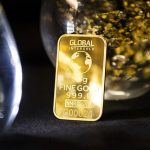If you’re thinking about creating a precious metals portfolio, below is an example portfolio. It is important to note that this example portfolio is tailored for a hypothetical investor seeking diversification, stability, and some growth potential through precious metals.
We’re not suggesting this example is right for you, but what we are suggesting you study the example, do your own research, and create a precious metals portfolio that fits your personal circumstances.
Creating Your Precious Metals Portfolio
Let’s say you have an investment portfolio of $100,000 (example amount) that you wish to invest entirely in precious metals.
Let us also say your objective is Wealth preservation, inflation hedge, moderate growth, and mitigating risk.
Our Example Allocation:
- Gold (60% – $60,000):
- Rationale: Gold is a safe-haven asset, historically stable during economic uncertainty and inflation. It’s a core holding for wealth preservation.
- Form:
- Physical Gold (30% – $30,000):
- Gold bullion bars (1 oz or 10 oz) or coins (e.g., American Gold Eagle, Canadian Maple Leaf) for liquidity and authenticity.
- Store in a secure vault or insured home safe to minimize storage risks.
- Gold ETFs (20% – $20,000):
- For low-cost, liquid exposure without physical storage hassles.
- Gold Mining Stocks (10% – $10,000): Diversified miners for leveraged exposure to gold prices with growth potential.
- Physical Gold (30% – $30,000):
- Silver (25% – $25,000):
- Rationale: Silver offers higher volatility and growth potential than gold, with industrial demand (e.g., solar, electronics) driving upside. It’s less liquid but complements gold’s stability.
- Form:
- Physical Silver (15% – $15,000):
- Silver bars (100 oz) or coins (e.g., American Silver Eagle) for affordability and liquidity.
- Consider allocated storage to avoid counterparty risk.
- Silver ETFs (10% – $10,000):
- For easy trading and exposure to silver spot prices.
- Physical Silver (15% – $15,000):
- Platinum (10% – $10,000):
- Rationale: Platinum is undervalued relative to gold (as of 2025 pricing trends) and has industrial applications (e.g., automotive catalysts). It offers diversification and speculative growth.
- Form:
- Physical Platinum (5% – $5,000): Platinum bars or coins (e.g., Platinum Maple Leaf) for direct exposure.
- Platinum ETFs (5% – $5,000): For liquidity.
- Palladium (5% – $5,000):
- Rationale: Palladium is a smaller market with high volatility, driven by automotive demand (catalytic converters). A small allocation adds diversification and speculative potential.
- Form:
- Palladium ETF (5% – $5,000): For ease of access, as physical palladium is less common.
Investing Disclaimer:
This content is for educational purposes only. The sole purpose of this content is to educate the reader, not to provide investing strategies or recommended investing suggestions. All investing involves risk please contact your licensed financial advisor for personal investment advice.








